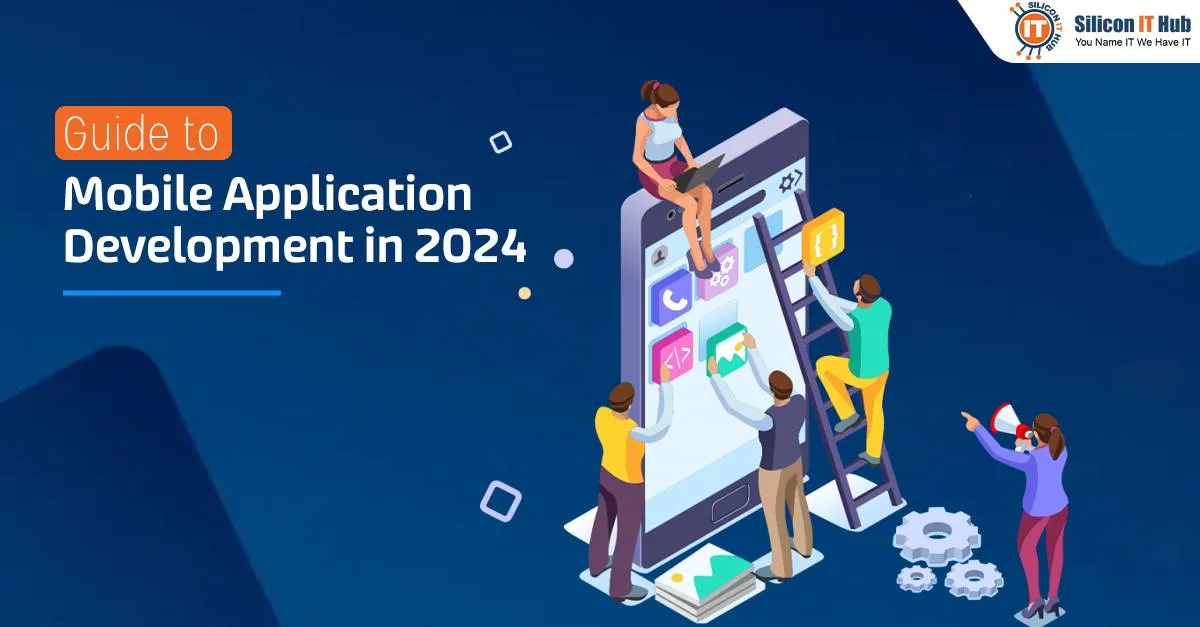All You Need to Know about Mobile Application Development in 2024

Introduction
The booming mobile app development domain is getting bigger steadily. As per the report, the global app market was valued at USD 139 billion in 2023, and expected to reach a whopping USD 406 billion by 2026 with a CAGR of over 27 percent. As technology evolves, mobile app development services become more capable of addressing the complexities and challenges of modern businesses. This is a reason the mobile app market value has touched new heights.
A tailored mobile app can take your business to a new level by improving services, bringing automation, streamlining processes, and increasing customer satisfaction. Are you planning to give your company an edge over competitors through a custom mobile app? If your answer is ‘yes’, this detailed guide is for you. If your answer is ‘no’, this post will also help you make the right decision. Let’s start with the key stages of developing enterprise mobile apps
Key Stages in Mobile App Development

Mobile app development is an umbrella term that refers to the process of creating customized applications for mobile devices like smartphones and tablets. It starts with conceptualization and ends with regular updates and maintenance. Let’s understand all six steps for mobile app development services.
Step 1. Ideation and Planning
It all starts with a creative, brilliant idea that aims to solve a problem or fill a gap in the market. This initial stage involves defining your target audience, outlining core features, and conducting thorough market research to ensure your app’s viability.
Step 2. Design and Wireframing
Once a blueprint is ready, the mobile app development company’s role begins with design and wireframing. Here, user interface (UI) and user experience (UX) designers take care of the app’s visual appeal and functionality.
Step 3. Application Development
Companies can hire mobile app developers who can bring the wireframes to life. The usage of cutting-edge tools and specific programming languages can make a difference. This stage involves meticulous coding to ensure optimal performance.
Step 4. Application Testing
Proper and rigorous testing is essential before unleashing your app to the world. Experienced app testers scrutinize the app’s functionality, performance, and security across different devices in specific OS. This step can identify and eliminate bugs to ensure seamless functionality.
Step 5. Application Deployment
Finally, your app is ready to make its grand debut on the App Store or Google Play Store! But the work is still pending as you should make an app promotion policy to make your app more popular across app stores.
Step 6. Application Maintenance and Upgrade
This is an ongoing process. It includes monitoring user feedback, addressing any issues that arise, and releasing newer versions of your customized applications. This crucial step can help your app thrive in a highly challenging scenario. All these steps can work well only if you choose the right app development platform. You need to think about whether you want to build a native app or a cross-platform app. We will also discuss the third option in the following section.
How to Choose the Right Mobile App Development Platform
When you choose to build a mobile app, a mobile app development company can give two options- native app development and cross-platform app development. However, the third option is also available and these days it is in vogue. It is a progressive web application or PWA. Let’s understand these three options and go through some useful tips for choosing the most suitable mobile app development platform .

Image Sources: IDC, StatCounter
Native Application
It needs the support of platform-specific development language and native tools. You can hire mobile app developers who are experts in developing Android or iOS apps. The biggest drawback of native apps is they can run only on a particular platform.
Cross-platform/Hybrid Application
Cross-platform App Development is gaining popularity swiftly globally. Ionic, React Native, and Flutter are major cross-platform app development platforms. These apps require a single code to run on multiple platforms and devices.
HTML5 Web Application or PWA
This is an optimized mobile website that acts as a native application and runs on the mobile browser. As a web application, PWA remains platform-independent and lags in offering a superior user experience.
Read on to get some tips for selecting the most suitable type of app.
When to Select What Type of Application
The selection of app type depends on multiple factors including target audience, budgetary limitations, business objectives, etc. Here we give some tips for selecting the specific type of app for your company-
1. Native Apps
These apps are ideal when you need high performance from complex apps that have full access to various device features. Talking about the target audience, if a majority of your target audience stays in the USA, it is better to opt for an iOS app development, whereas, you can reach Asian and even European target audiences effectively by selecting an Android OS.
2. Cross-platform Apps
If rapid development, wider reach across major platforms, and a limited budget are your project characteristics, it is better to go for cross-platform app development. However, these apps have some drawbacks in performance and limited access to device-specific features.
3. PWAs
This type of application is perfect if you want to offer app users a web-like experience on their mobile devices. PWAs are popular for reduced development costs and, the capability of working across different platforms and devices. However, they lack some native functionalities.
However, it is always better to consult a reputed mobile app development company with feature requirements to get assistance in choosing the right type of application.
Essential Tools and Technologies for App Development
As per Statista report, we have over 3.8 billion smartphone users worldwide. It fuels mobile app development services to thrive. Moreover, evolving technology contributes to making tailored apps more advanced. Let’s dig deep into popular tools and technologies useful in making feature-rich mobile applications.

Image Source: openxcell
1. React Native
This Facebook-powered framework is useful for creating native Android, iOS, and web applications. Skype, Airbnb, Amazon Prime, etc. are popular React Native apps.
2. Flutter
It can transform the cross-platform app development process by offering cutting-edge development tools and a single codebase for mobile, web, and embedded apps.
3. BuildFire
It offers high-end custom development capabilities in an innovative DIY platform. It is a simple yet attractive UI with a drag-and-drop feature to build an iOS or Android application.
4. Java or Kotlin
Both Java and Kotlin are the official programming languages of Android OS. You can hire Android app developers to build a tailored business app using either of these languages.
5. Objective C or Swift
Both these are official programming languages to build tailored applications for iPhones. It is easy to combine these languages with Xcode tools to make engaging apps.
6. Xcode
It is Apple’s integrated development environment. Useful for developing custom software for macOS, iOS, watchOS, and tvOS, Xcode can take the development process to a new level.
7. Android Studio
It is an Android development software. Built and maintained by Google, Android Studio can provide shortcuts for coding and design in an easy-to-use layout designer.Apart from these, Appcelerator, Sencha Touch, Cordova, Corona Labs, etc. are other famous tools for developers.
Why UI and UX Matter in Your Business Application
How about having a business app with complex navigation, hidden buttons, and difficult-to-read text? It is frustrating for users and results in failure, right? This is an outcome of poor UI and UX designs. Good UI/UX design can take users through a website or app effortlessly. It makes things easy to find, use, and understand, leaving users feeling happy and accomplished. It can increase conversions, enhance brand image, reduce costs, and improve user satisfaction.
It is fair to mention that good UI/UX is not just about aesthetics, it is about building a bridge between users and your product. However, it is essential to follow some design principles and standard design practices to get an attractive UI and seamless UX.
User-centric Design
Put your users first! You need to understand their needs and goals and design everything around them.
Usability
You can make things easy to find, understand, and use. Think clear labels, intuitive layouts, and consistent navigation.
Visual Hierarchy
You can draw the user’s attention to the most important elements first. Use size, color, and spacing to create a clear visual flow.
Consistency
It is essential to maintain a consistent look and feel across your application. This builds trust among users.
Feedback
You need to pay attention to the initial user’s feedback so that you can easily make the necessary changes.
By following these principles and best practices, you can create elegant, functional, and user-friendly UI/UX. The next important factor is the security of mobile apps .
For Users
Users should download the app from trusted sources like Google Play Store and Apple App Store. It is necessary to understand the app permissions before granting. Most companies offer updated versions of their apps regularly. Users should use that version to ensure a seamless performance and added security. Finally, it is always beneficial to use strong passwords and change them regularly. Two-factor authentication is also beneficial to enhance app security.
All these standard practices can enable developers and users to get a safer mobile app ecosystem. However, it is fair to mention that security is an ongoing process and continuous improvement is essential to protect valuable data.
Want to Hire a Mobile App Developer for Your Business?
Best Practices for Mobile App Security
Mobile app development services offer immense opportunities but security risks loom large. It is, therefore, necessary to identify threats and implement preventive measures to keep valuable corporate or personal data intact. If we think of best app security practices, it is necessary to consider the role of developers and users. Let’s go through these best practices in brief:
1. Code Safety
Developers can encrypt and obfuscate your source code to make it harder for attackers to understand and break.
2. Data Protection
It is better to encrypt sensitive data at rest and in transit for an additional security level. It can help users make sure that their data is safe.
3. Strong Authentication
Developers implement multi-factor authentication and biometrics for secure access, and encourage users to use strong passwords.
4. Secure APIs
It is necessary to harden your APIs by implementing strong authentication, authorization, and encryption.
5. Regular Testing
You can hire dedicated mobile app developers to conduct penetration testing and security audits to identify vulnerabilities regularly.
Common Security Threats for Mobile Apps
Mobile apps are prone to cyberattacks and hacking as a soft target. Malicious code, data breaches, unreliable third-party APIs, shoddy encryption, and inadequate authentication are some of the most common yet dangerous threats for custom mobile apps. However, mobile app development services enable your app to address these threats effectively. From the user’s perspective, at times, insecure internet or broadband connection can lead to hacking. Moreover, hackers can use phishing, fake advertisements, and manipulation tricks to get access to the user’s apps. It is, therefore, necessary to remain alert while using a tailored mobile app.
Importance of Testing and Quality Assurance
A custom mobile app with user-friendly features and flawless functionality can be a game-changer for modern companies. When it comes to ensuring the functionality or performance of the application, testing and QA (Quality Assurance) play a crucial role.
First, let's see the types of app testing methods.
1. Unit Testing
It scrutinizes small code modules in isolation, ensuring they function flawlessly. Unit testing is the most basic testing method.
2. Integration Testing
It checks how different modules work together, ensuring smooth communication and seamless functionality.
3. Functional Testing
It verifies if every feature and button works precisely as intended, from user logins to complex in-app tasks.
4. Performance Testing
It simulates heavy usage scenarios, ensuring the app remains stable, responsive, and efficient under pressure.
5. Security Testing
It identifies possible vulnerabilities that hackers could exploit. This crucial step protects user data and keeps your app safe.
Once the QA and testing teams give green signal to your bespoke business app, the next stage is its deployment and distribution.
Your Brief Guide on App Deployment and Distribution
Launching an app on either Google Play Store, Apple App Store or both is a herculean task and requires you to follow respective submission processes and standards. Here is a breakdown of each app store:
Google Play Store
While Google Play Store is an open market, it too has its own set of guidelines that act as guiding stars for developers. Developers can set up a Google Play Developer account and give detailed information including target audience, permissions, and content rating. Google's Play Console then guides you through a streamlined process, helping you optimize your app's listing and prepare for release. Unlike the App Store's gatekeepers, Google relies on automated filters and user reviews to flag potential policy violations. However, it is important to ensure your app adheres to their extensive Developer Policy Center.
Apple App Store
Like Google Play Store, developers begin by creating an Apple Developer account and crafting compelling app descriptions, screenshots, and keywords. Then, your app undergoes a rigorous review process. Apple has imposed stringent regulations to ensure the quality of published apps and their performance. It includes adhering to technical specifications, design principles, and content restrictions for sensitive topics, privacy, and monetization practices. Once the app passes through the approval process, you can address a huge audience of affluent iPhone users across the world.
Why Post-launch Strategies Are Essential
Post-launch strategies also require careful diligence because they can give your app the fuel to go ahead in intense competition. You can act on early feedback and opt for regular upgrades to gain ground for your newly launched application. Here, it is fair to mention that the app journey never ends and you continuously need to monitor its performance from various aspects.
Concluding Lines
Having a seamless and user-friendly mobile app with desired features can drive growth, promote your business, and bring automation to multiple activities. It can attract and retain customers with your company for a long time. Hope this comprehensive guide will help you get a successful application for your company. However, it is advisable to consult a reputed and reliable mobile app development services provider to ensure pre and post-development processes with the necessary accuracy and consistency.
Silicon IT Hub is a renowned mobile app development company that can make high-end applications with advanced features. Our in-house teams of experienced app developers can integrate technological advancements to make your business app ready for the future. Want to know more about our top-notch mobile app development services? Send us an email at info@siliconithub.com and our experienced consultants will get back to you.








